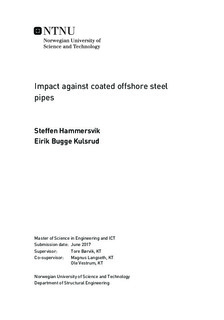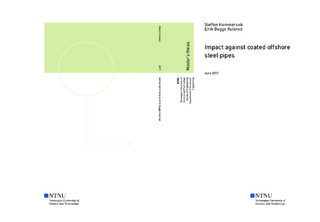| dc.description.abstract | This thesis is part of an ongoing research program between SIMLab and Statoil about impacts on coated offshore pipelines. Impact loads may occur from objects such as anchors or trawls, causing severe damage to the pipe which may lead to oil or gas production to shut down. The steel pipe had been sufficiently researched concerning the impact event, but much work remained on the coating.
The coating investigated in this thesis was the five layer polymer insulation system, Thermotite, produced by Shawcor (formerly Bredero Shaw). The main focus was to characterise the porous polypropylene layer. Experiments were conducted; X-ray computed tomography to get a look inside the coating and determine the pore morphology by image analyses, and uniaxial compression tests to investigate the mechanical properties.
Image analyses suggested several statistics of the pore structure. The results showed that the morphology is highly inhomogeneous and anisotropic. Furthermore, the relative density was varying between 0.7 to 1.0 depending on the radial coordinate of the pipe. The lowest value was found in the middle. The pore structures on either side, were different (asymmetric morphology). The reason for that was assumed to be the extrusion process during manufacturing. The other directions (hoop and axial) revealed no dependency.
The uniaxial compression tests suggested that the pores affect the strength of the polymer significantly. The different pore structures seemed to have a distinct effect on the force-displacement behaviour. The coating was characterised as a solid with isolated pores, not foam because the transverse expansion was greater than zero and the high relative density. Compression tests on solid polypropylene were employed to establish a material model, calibrated by the use of edge tracing and inverse modelling. The model assumed isotropic hardening and insensitivity to temperature, pressure, and strain rate.
To numerically re-create the test specimens, a direct modelling technique was employed. The method utilises the computed tomography image slices to replicate the samples. A sensitivity study indicated that the accuracy of the models was sensitive to mesh size, friction and the material model properties. Compared to the experimental values, the simulations were satisfactory, but a bit stronger, most likely due to insufficient mesh refinement. However, the models captured the shape of the deformation and the force-displacement curves.
The numerical models were employed to characterise the coating further. The simulations suggested that the reduction in yield force is due to strain localisation between adjacent pores. Simulations of the re-created specimens subjected to tension suggested that the tensile strength is significantly lower than the compressive strength, as the strain gets strongly localised. Mechanical anisotropy (orthotropy) was investigated as well. The results indicated differences throughout the height of the porous layer, and that the coating was weaker when compressed in the radial direction.
A block of porous polypropylene layer was simulated under compression. To re-create the pore structure of the coating satisfactorily, the block needed about one million elements. Therefore, it was assumed that a large-scale simulation of the pipe with the direct modelling technique would require too many elements. | en |

